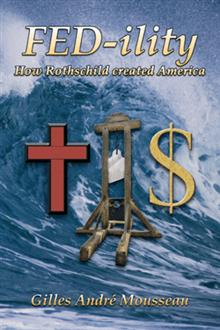Haym Salomon financed the Patriots in every possible way and that included the politicians in Philadelphia. He looked after the Hessian soldiers for the English, but he was sent by Rothschild primarily to double-cross the English which he started to do as early as June 15th, 1775. That was the day a George Washington dressed in a flashy, custom-made military uniform tailored for the occasion, went before the second Continental Congress in Philadelphia to offer his services. Because he was a Southerner with some military experience, and because he insisted on not receiving any salary, he was a shoe-in to head the Continental Army that didn’t yet exist. He even offered to raise an army and work for free with the proviso that his expenses be reimbursed at the end of the war, an arrangement which has always been considered very bizarre. Haym Salomon was the only financier who had the wherewithal to back George Washington, and the statue in Chicago showing the General shaking Haym Salomon’s hand with a Robert Morris looking on speaks volumes.
Washington was not a wealthy man even though over the years he did manage, in a roundabout way, to inherit property from the very important Dandridge, Fairfax, and Custis families. However, in 1775, the property known today as Mount Vernonwas a rather modest estate with few slaves and little revenue. What is noteworthy is that at the outset of the War of Independence, George Washington had enough money to purchase an additional 6000 acres and build the north and south wings that transformed the house into the extraordinary mansion that it is today. Very odd, indeed!
In 1775,Washington had more money than he knew what to do with. During the war, he spent lavishly on fine wines, fine foods, fine leathers, fine attires, and generally enjoyed a lifestyle reserved to English aristocrats. He even commissioned forty-two paintings to immortalize his feats of bravery. Another odd aspect of his command was his retinue of thirty-two young men he called his “family.” One can only wonder about the kind of relationship Washington entertained with his “family,” for in 1781, when Alexander Hamilton became aware that the Marquis de Lafayette had become the General’s new favorite, he abruptly quit his service and, thereafter, wrote him many letters venting his ire.
At the end of the war, Washington presented Congress with a $449,261.51 tab. If we compare a captain’s salary of $20 per month then and $4,000 per month today, the General’s expenses amounted to close to a billion of today’s dollars. He even charged $3,776—the equivalent of $700,000 today—for personal expenses incurred while retreating across the Delaware, a river barely 200 hundred yards wide. That was the same banal river crossing that’s immortalized in the painting Crossing the Delaware.
For a general who went around showing the colors, laying the odd siege, and mainly retreating during the seven years the war lasted, that was good pay. More to the point,Washington was not a trained military man and he never had a meaningful victory. The alleged one at Trenton seems to have been a cross-river rendezvous operation to pick up Salomon’s gold from New York along with some nine hundred Hessian troops that the latter had persuaded to defect. Washington had very little to do with the victory at Yorktown, either, for any military buff will readily certify that the victory at Yorktown was due to the brilliant plan laid out by the Comte de Rochambeau, a competent professional soldier trained in the art of war, and Admiral de Grasse’s great seamanship. The battle plan was so well carried out, there were very few casualties: five hundred for the British, eighty for the Americans, and two hundred for the French. In the history of America, the Battle of Yorktown may have been a decisive moment, but it wasn’t Washington’s doing.
When all is said and done,Washington seems to have been a flawed individual, a megalomaniac who was bought, wrapped, and delivered by Rothschild’s man, Haym Salomon. The President has been Rothschild’s ‘play’ mate right from day one.
